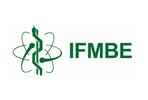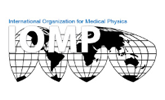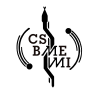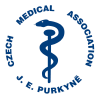- MENU
- Hosts & Auspices▼
- Committees▼
-
Programme▼
- Scientific Programme
- IUPESM/IFMBE/IOMP Meetings
- Main Topics
- Invited Speakers for Plenary Session
- President´s Keynote Lectures
- Key-Note Speakers
- Educational Sessions
- Scientific Visits
- Instructions for Speakers (Authors)
- Instructions for Poster Presenters
- Call for Special Sessions
- Call for Abstracts
- Call for Papers
- Registration▼
- Accommodation▼
- Sponsorship & Exhibition▼
- Events▼
- General Information▼
- Contacts
NEWS
June 13, 2018
Find here on flickr PHOTOS from IUPESM 2018 World Congress.
June 11, 2018
Certificates of Participation will be available to download from Wednesday June 13.
May 31, 2018
Final Programme
Final programme is available HERE
May 30, 2018
Before you go
Please find the most updated and useful information HERE
May 10, 2018
Regular Registration Deadline
The regular registration deadline: May 15, 2018. Register before this deadline to receive the reduced rate
May 2, 2018
MPCEC Credits
The IUPESM 2018 World Congress Continuing Education Program has applied to be CAMPEP accredited for up to 78,5 MPCEC credits.
April 29, 2018
Scientific Programme in Details
Find the Scientific Programme in details in HERE.
April 12, 2018
EBAMP Accreditation
EBAMP accredits the World Congress on Medical Physics and Biomedical Engineering. The event has been judged according to the EBAMP protocol and it has been accredited by EBAMP as CPD event for Medical Physicists at EQF Level 7 and awarded 38 CPD credit points.
March 6, 2018
See the abstracts of the Presidents Keynote Lectures, Keynote Speakers and Educational Sessions
January 26, 2017
Dear participants. We would like to offer you wide range of the tours during the Congress. Please find more information HERE
January 1, 2018
We would like to wish you all the best in 2018.
December 15, 2017
We have already received more than 1500 abstracts! We would like to thank all those who have sent an abstract for review. Final extension of abstract submission deadline: January 31, 2018. Abstracts submitted in the period from December 20, 2017 to January 31, 2018 that are accepted will only be included in the Book of Abstracts. Authors of these abstracts will not be allowed to submit full papers.
June 22, 2017
All registered participants will receive free PUBLIC TRANSPORT TICKET (received on-site at the registration desk and will be valid within the dates of the congress).
June 17, 2015
Assoc. Prof. Lenka Lhotska, Ph.D., The Czech Society for Biomedical Engineering and Ing. Josef Novotný, Czech Association of Medical Physicists are drawing the winners of FREE REGISTRATION for IUPESM 2018.
IMPORTANT DATES
January 31, 2018
Extended Abstract Submission Deadline
February 5, 2018
Full Papers Submission Deadline
February 20, 2018
Authors Notification of Abstract Acceptance (abstracts submitted from December 20 to January 31)
March 5, 2018
Notification of full paper acceptance
March 15, 2018
Registration fee payment deadline for inclusion of the abstract / full paper in the Programme and in the Book of Abstracts/Proceedings
VISITORS
Keynote Speakers
To read the abtracts of each presentation, please click on the title of the presentation.Main Topic: BME and MP Education, Training and Professional Development
Presentation title: Professional development through e-learning: A walkthrough of the AAPM Online Learning Center
Charles Bloch
Radiation Oncology, University of Washington, Seattle, United States
Main Topic: BME and MP Education, Training and Professional Development
Presentation title: Preparing young medical physicists for future leadership roles
Carmel J. Caruana
Medical Physics Department, University of Malta, Msida, Malta
Main Topic: Health Technology Assessment
Presentation title: Medical technology assessment in radiation medicine
Kin Yin Cheung
Medical Physics & Research Department, Hong Kong Sanatorium & Hospital, Hong Kong, China
Main Topic: Accreditation and Certification
Presentation title: Accreditation and Certification in Medical Physics
John Damilakis
Medical Physics, University of Crete, Heraklion, Greece
Certification is the recognition of knowledge of a professional who has completed his/her education or training. EFOMP has established recently its examination board (EFOMP’s Examination Board, EEB) to facilitate the harmonization of Medical Physics education and training standards throughout Europe. EEB has introduced the European Diploma of Medical Physics (EDMP) and the European Attestation Certificate to those Medical Physicists that have reached the Medical Physics Expert level (EACMPE). EEB examinations are designed to assess the knowledge, skills and competences requisite for the delivery of high standard Medical Physics services and are voluntary. The International Medical Physics Certification Board (IMPCB) has also been established to support the practice of medical physics through a certification program in accordance with IOMP guidelines.
Main Topic: Advanced Technologies in Cancer Research and Treatment
Presentation title: Particle therapy technology: Have we reached the future?
Jay Flanz
United States of America
Presentation title: Future Needs of Biomedical Engineering Education
James Goh, Alberto Corrias
Biomedical Engineering, National University of Singapore, Singapore, Singapore
Main Topic: Biosignals Processing
Presentation title: Dry electrodes for electroencephalography
Jens Haueisen
BMTI, TU Ilmenau, Ilmenau, Germany
This presentation introduces novel multi-channel EEG caps with dry electrodes. The base material of the EEG cap is a light-weight and flexible fabric, which contains small holes (perforation) making it breathable. Polyurethane (PU) based multi-pin electrodes serve as dry contact electrodes. A coating provides electrical conductivity of these polymer based electrodes. The use of silver coating opens the way for dry AgCl electrodes and thus, signal quality similar to wet Ag/AgCl electrodes. Thin coaxial wires are soldered to the bottom of the electrodes enabling active shielding. A second layer of fabrics protects the electrodes and the wires.
Our results demonstrate that resting state EEG, eye movements, alpha activity, and pattern reversal VEP can be recorded with the novel dry multi-channel EEG caps with short preparation time and without significant differences between the novel EEG cap and a conventional cap based on wet Ag/AgCl electrodes.
In conclusion, the proposed novel multi-channel EEG caps with dry electrodes can potentially replace conventional wet multi-channel EEG caps and thus enable new fields of application like brain-computer-interfaces and mobile EEG acquisition.
Main Topic: Radiation Oncology Physics and Systems
Presentation title: Learning from every patient treated
Marcel van Herk
United Kingdom
Main Topic: Diagnostic and Therapeutic Instrumentation
Presentation title: Additive manufacturing in medicine and tissue engineering
Radovan Hudak, Jozef Zivcak
Department of Biomedical Engineering and Measurement, Technical University of Kosice, Košice, Slovakia
Main Topic: Modelling and Simulation
Presentation title: The IUPS Physiome Project
Peter Hunter
Auckland Bioengineering Institute, University of Auckland, Auckland, New Zealand
Main Topic: Clinical Engineering
Presentation title: Biomedical and Clinical Engineers: live and learn
Ernesto Iadanza
Department of Information Engineering, University of Florence, Firenze, Italy
I had the priviledge of chairing the Clinical Engineering Division of the International Federation for Medical Biological Engineering for three years (2015-18) and to learn a lot from the past mistakes, that often prevented this beautiful profession from achieving the world recognition that it deserves.
I will discuss the main actions taken in the last years, as well as the many skills and abilities that today’s and tomorrow’s engineers will have to master to face the new challenges that, day after day, the complex world of healthcare is preparing for us all.
Main Topic: Biosignals Processing
Presentation title: Dynamical analysis of EEG and MEG for localization of the epileptogenic focus, prediction and control of seizures
Leon Iasemidis
Biomedical Engineering, Louisiana Tech University, Ruston, United States
Main Topic: Modelling and Simulation
Presentation title: Monte Carlo simulation of early biological damage induced by ionizing radiation at the DNA scale: overview of the Geant4-DNA project
Sebastien Incerti
CNRS, Gradignan, France
Main Topic: Biological Effects of Ionizing Radiation
Presentation title: DNA double strand break repair: the choices and limitations
Penelope Jeggo
Genome Damage and Stability Centre, University of Sussex, Brighton, United Kingdom
Presentation title: Public Health in the Era of Big Data: From Online Evidence to Serious Games
Patty Kostkova
IRDR, University College London, London, United Kingdom
In this presentation we will outline the issues surrounding the dissemination of medical evidence and understanding public information needs from Internet search weblogs analytics. Educational effectiveness of serious games highlights the opportunity mobile technology brought to training, community engagement and behaviour change. Social networking with increasing amount of user-generated content from social media and participatory surveillance systems provide readily available source of real-time monitoring and epidemic intelligence.
In this talk, we will draw from several mobile technology projects aimed at citizens in low and middle income countries. In particular, mobile training and crowdsourcing for community engagement to combat the zika virus in Brazil, social media use for vaccination campaigns, early warning epidemics dashboard, and serious mobile games for increasing resilience and disaster preparedness in perinatal women in Nepal.
Main Topic: Image Processing
Presentation title: Benchmarking of algorithms for biomedical image analysis
Michal Kozubek
Centre for Biomedical Image Analysis, Masaryk University, Brno, Czech Republic
This talk summarizes recent developments in this respect and describes common ways of measuring algorithm performance as well as providing guidelines for best practices for designing biomedical image analysis benchmarks and challenges, including proper dataset selection (training versus test sets, simulated versus real data), task description and defining corresponding evaluation metrics that can be used to rank performance.
Proper benchmarking of image analysis algorithms and software makes life easier not only for future developers (to learn the strengths and weaknesses of existing methods) but also for users (who can select methods that best suit their particular needs). Also reviewers can better assess the usefulness of a newly developed analysis method if it is compared to the best performing methods for a particular task on the same type of data using standard metrics.
Main Topic: Diagnostic Imaging
Presentation title: Fast Field-Cycling MRI: a new diagnostic modality?
David Lurie, Lionel Broche, Gareth Davies, James Ross
School of Medicine, Medical Sciences & Nutrition, University of Aberdeen, Aberdeen, United Kingdom
FFC measures T1-dispersion by switching the magnetic field rapidly between levels during the pulse sequence, with relaxation occurring at the “evolution” field (usually a low value) and always returning to the same “detection” magnetic field (a higher value) for NMR signal measurement. FFC-MRI obtains spatially-resolved T1-dispersion data, by collecting images at a range of evolution magnetic fields.
We have built two whole-body human sized scanners, operating at detection fields of 0.06 T [3] and 0.2 T. The 0.06 T device uses a double magnet, with field-cycling being accomplished by switching on and off a resistive magnet inside the bore of a permanent magnet; this has the benefit of inherently high field stability during the detection period. The 0.2 T FFC-MRI system uses a single resistive magnet which has the advantage of increased flexibility in pulse sequence programming, at the expense of lower field stability during the detection period, necessitating more complex instrumentation.
We are investigating a range of applications of FFC relaxometry and FFC-MRI. Our work has demonstrated that FFC relaxometry can detect the formation of cross-linked fibrin protein from fibrinogen in vitro, through the measurement of 14N-1H cross-relaxation phenomena, known as “quadrupolar dips”. We have also shown that FFC-MRI can detect changes in human cartilage induced by osteoarthritis. Recent work has focused on speeding up FFC-MRI by incorporating rapid MRI scanning methods.
Main Topic: Biosignals Processing
Presentation title: Non-invasive assessment of cardioversion drugs through signal processing
José Millet Roig
ITACA. Biomedical Eng. LAb, Universitat Politecnica Valencia, Valencia, Spain
This presentation analyzes how these techniques are being applied to a new field of study such as cardioversion drugs, providing knowledge on how they can act non-invasively and analyzing the evolution of atrial dominant frequency together with other parameters in the spectrum (spectral concentration, second peak ratio, harmonics, etc.), observing the different behaviors associated with their effectiveness. In order to validate the information obtained non-invasively, the analysis shows a comparison between the parameters obtained through the ECG analysis and those obtained through a duo-decapolar catheter during an electrophysiology study, in which both recordings are obtained simultaneously. Much of the information can be obtained through advanced analysis of the ECG signal, although asynchrony and heterogeneity continue to be difficult to obtain. Ultimately, these advances can contribute to overcoming today’s challenging clinical questions in AF management.
Main Topic: Health Technology Assessment
Presentation title: Health Technology Assessment of medical devices: challenges, gaps and recent developments.
Leandro Pecchia
School of Engineering, University of Warwick, Coventry, United Kingdom
This talk will report on challenges and gaps met while assessing medical devices suggesting, when relevant, possible solutions.
Since 2014, the Applied Biomedical Signal Processing and Intelligent eHealth (ABSPIeH) Lab at the University of Warwick, directed by Dr Pecchia, focused on peculiar aspects of medical devices, and relevant scientific literature, which affect their assessment. For instance, in a recent study, the ABSPIeH lab demonstrated that even the positioning of a sensor, may affect the significance of a test based on medical devices. In a different study, performing field analysis in Sub-Saharan Africa, ABSPIeH lab tried to quantify the extent of which HTA reports can be reliable when assessing safety or effectiveness of medical devices in low income countries.
This talk will report on those experiences and will conclude presenting the significant effort made by the ABSPIeH, in cooperation with the IFMBE HTAD and the WHO, in order to produce pragmatic teaching material and guidelines on HTA of medical devices, which was designed specifically to meet the needs of medical physicists and biomedical engineers scientific communities.
Main Topic: Information Technology in Healthcare
Presentation title: Medical informatics; where's the data and how can it be used
Donald Peck
Medical Informatics, Michigan Technological University, Houghton, United States
Once you have the compete patient’s EMR it can still be difficult to find the needed data because there is often a lot of extraneous information that may hide what a clinician needs. So how do you find the relevant data? In addition, the data is often unstructured or there are structured and unstructured data combined. Consequently, an intelligent method to search and combine this data is needed. The EMR also needs to have a reliable method for updating personnel when critical findings are added to the EMR. But who should get this notification and how do you minimize notification overload? Also, how do you link a clinical recommendation to a result? This can make sure a patient’s care is done in a timely manner, but also provides data on outcomes that can increase the ability to determine the best treatment courses. In addition, there is much more data that needs to be accessible by clinicians to make the right decisions on care. Clinicians need to know all the latest advances and what experts in each area recommend.
This is just a small portion of things that are being done or are needed in medical informatics. A review of some of the methods that are being used to gather and analyze medical data will be presented.
Main Topic: Dosimetry and Radiation Protection
Presentation title: International radiation safety system - Advancements and challenges with its application in regulatory frameworks
Miroslav Pinak
NSRW/ Division of Radiation, Transport and Waste Safety, IAEA, Vienna, Austria
Main Topic: Diagnostic Imaging
Presentation title: MRI in patients with implantable electronic devices: a teamwork approach
E Russell Ritenour
Radiology and Radiological Sciences, Medical University of South Carolina, Charleston, South Carolina, United States
MR Safe pacemakers came onto the market in 2011, but the patient population will continue to have MR “Unsafe” PMs and ICDs for many years. Remnants of the devices, such as abandoned pacemaker leads, will continue for some patients’ lifetimes and the number of patients needing MRIs will increase as the population ages. Despite the growing patient population, many hospitals still view the presence of PMs/ICDs as a contraindication for MR imaging, particularly of the thorax. Until recently, even some academic centers in the US have opted not to scan such patients or to limit their scanning to modalities other than MRI.
In this presentation, current literature and general recommendations of scientific and professional societies as well as regulatory bodies in the US and Europe will be reviewed. The Medical University of South Carolina (MUSC), an Academic Center for the Southeast of the United States has been scanning such patients for several years. This undertaking is an example of the use of a teamwork approach to hospital policy, an approach in which members of different disciplines and different departments work in concert to meet the medical and safety challenges of relatively new medical issues. Specific procedures, guidelines for pulse sequences, Specific Absorption Rate, electronic lead configuration, review of vendor information, and the steps for medical approval followed at MUSC will be presented.
Main Topic: Patient Safety
Presentation title: Medical devices safety – still current topic
Milan Šantrůček
Electrotechnical Testing Instituite,s.p., Praha 8, Czech Republic
On the other hand, when putting a medical device on the market, the main goal is to safeguard the public health and to offer an effective and no compromizing therapy or diagnose. Therefore, it is crucial that manufacturers are complying with these requirements to highest possible level during the whole lifecycle of the device.
In the presentation, different aspects of safety of medical device will be discussed and also a short overview of safety requirements in the new regulations will be presented.
Presentation title: Next generation multi-electrode array technologies for neuroscience and cardiology: challenges, progress and opportunities
Misha Spira
Neurobiology, E. Safra campus, Jerusalem, Israel
Nevertheless, even the most sophisticated MEA used nowadays suffer from critical drawbacks such as poor signal to noise ratio, inadequate source resolution and instabilities overtime. These sever shortcomings are attributed mainly to the nature of the interfaces formed between living cells and the MEA devises.
In the presentation I will review the field focusing on novel breakthrough bioengineering approaches to generate the next generation neurons/cardiomyocytes-MEA interfaces to overcome the present shortcomings.
Main Topic: Patient Safety
Presentation title: Skin injuries in interventional procedures: What the Medical Physicist needs to know
Virginia Tsapaki
Medical Physics Department, Konstantopoulio General Hospital, Nea Ionia, Greece
Main Topic: Image Processing
Presentation title: Challenges in quantitative medical image analysis
József Varga
Department of Medical Imaging, Nuclear Medicine, University of Debrecen, Debrecen, Hungary
Emission imaging (by gamma camera or PET) is inherently deteriorated by noise, attenuation, scatter, limited and position-dependent resolution, and physiological motion (heart beat and respiration). All these factors should be addressed to obtain the most accurate, precise and biologically meaningful results possible. We shall review the methods for, and limitations of SPECT and PET reconstruction with the embedded correction steps, and the principles how image quality may be measured and optimized.
Hybrid imaging and multimodality image processing, while offering the potential for improving our accuracy, may introduce additional sources of error, originating from misalignment, different circumstances, and propagating artifacts.
Take-home message of the review is that when utilizing sophisticated image processing algorithms, we should always be aware of the possible sources of error, and carefully validate the methods before introducing them to our clinical or research work.
Main Topic: Neuroengineering, Neural Systems
Presentation title: Neural implants for therapy and enhancement
Kevin Warwick
Office of the Vice Chancellor, Coventry University, Coventry, United Kingdom
Main Topic: Accreditation and Certification
Presentation title: Certification of Clinical Medical Physicists: How to uphold the standard globally
Raymond Wu
Chief Executive Office, International Medical Physics Certification Board, Phoenix, United States
Main Topic: Minimum Invasive Surgery, Robotics, Image Guided Therapies, Endoscopy
Presentation title: Medical Robotics – Successes, Challenges, and the Road Ahead
Guang-Zhong Yang
The Hamlyn Centre, Imperial College London, London, United Kingdom
Main Topic: Nuclear Medicine and Molecular Imaging
Presentation title: Quantitative imaging biomarkers using PET/MRI
Habib Zaidi
Nuclear Medicine & Molecular Imaging, Geneva University Hospital, Geneva, Switzerland






